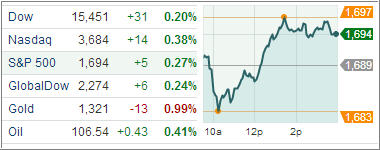U.S. equities finished strong in a volatile session on Tuesday, as investors weighed a lackluster domestic retail sales report and tepid small business optimism with better-than-expected reports from across the Atlantic.
Treasuries finished lower following the US data; gold saw pressure, while crude oil prices and the US dollar moved higher. Below-average volume has persisted through August, and today did not deviate from the recent norm as only about 5.6 billion shares changed hands on the New York Stock Exchange, the Nasdaq and NYSE MKT, which is below the daily average so far this year of about 6.3 billion shares. The Standard & Poor’s 500 Index incurred another morning losses for a ninth consecutive day. The rebound in the S&P was aided by the relative strength of most cyclical groups.
The tech sector spiked during afternoon action after activist investor Carl Icahn disclosed what he described as a “large” position in Apple. The largest tech stock advanced 4.8% while the broader sector added 0.8%. While most cyclical sectors posted solid gains, discretionary shares ended flat. Home builders registered losses across the board.
On economic front, retail sales rose 0.2% in July, its fourth gain in a row, but slightly below the consensus of 0.3%. The increase suggests consumer spending remains a positive contributor to growth in the beginning of 2H, despite some slowing in housing related sectors.
Discretionary spending growth varied between 4.1% and 6.4%. Meanwhile, the NFIB Small Business Confidence Index rose 0.6 points to 94.1 in July. It has averaged 90.9 during the current expansion, well below the historical average of 98.2, as small business optimism remains subdued.
Import prices turned up 0.2% in July, its first increase in five months, but well below the consensus of 0.8%. Fuel prices advanced 2.5%, led by a 3.2% gain in petroleum. Excluding fuel, import prices continued to decline, down 0.4%, matching its biggest decline since June 2010.
Overseas, German economic sentiment surged to a four-month high of 42.0, compared to 36.3 in July exceeding the consensus. Providing further indications of the possible end to the recession in Europe, eurozone industrial output rose 1.0%, its fastest pace in nearly 2 ½ years, exceeding the projected rise of 0.7% by analysts.
Meanwhile, China’s Shanghai Composite Index and the Hong Kong Hang Seng Index advanced, as economic sentiment continued to rise throughout the region.
Our Trend Tracking Indexes (TTIs) offered a mixed picture, as the Domestic TTI slipped to +3.16% while the International TTI rose to +6.86%.
Contact Ulli
